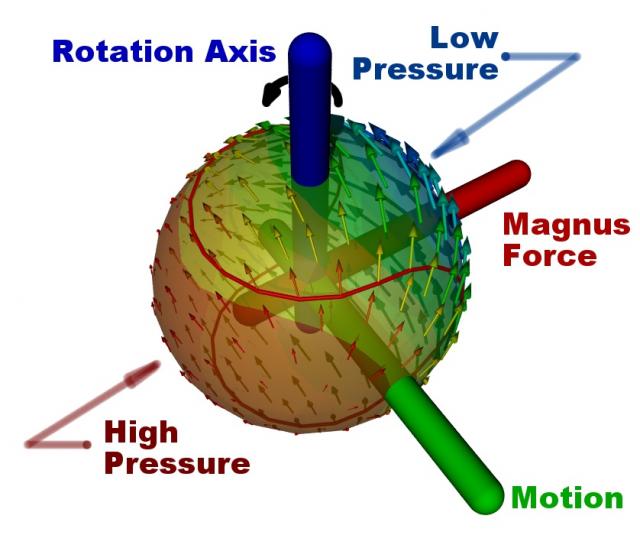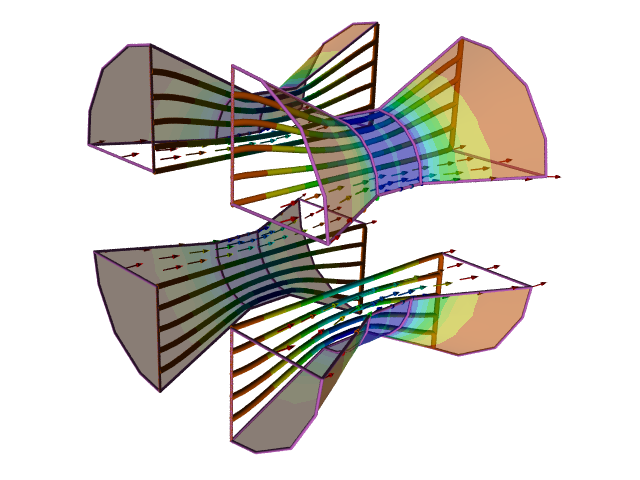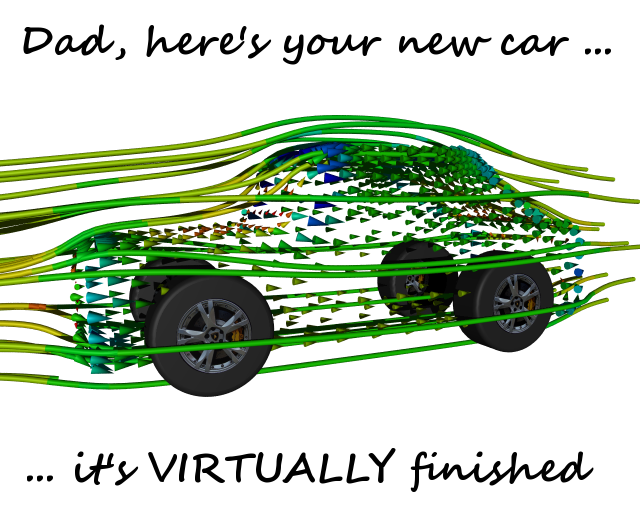
Simulation for Illustration
Sometimes an accurate simulation of a realistic scenario such as the aerodynamics of a racecar, is too much. Sometimes all that is needed is a simulation that highlights a simple concept or idea – welcome to simulation for illustration.
 Curve Ball ExplanationGeometry created and simulated using our Caedium Professional add-on, rendered in POV-Ray and annotations added in GIMP
Curve Ball ExplanationGeometry created and simulated using our Caedium Professional add-on, rendered in POV-Ray and annotations added in GIMP
Background
Engineers require high-fidelity simulations such as those produced by Computational Fluid Dynamics (CFD) to make crucial product design decisions. At the other end of the simulation spectrum are movies, where aesthetic considerations override reality – how many cute, talking animals have you seen outside of the movie theater? Somewhere in-between these two extremes are technical illustrations that serve to explain physical phenomenon (such as the marketing material Dyson uses to describe how their vacuum cleaners work) in product manuals, marketing materials, websites, newspapers, magazines, web forums etc. To produce these illustrations ideally the software should be easy to learn and use, reasonably accurate, and integrated.
Advances in the ease-of-use of Computer-Aided Engineering (CAE) tools with single, unified simulation environments (such as Caedium) make it feasible for technical illustrators to incorporate simulation results directly into their work. Some level of simulation fidelity can be sacrificed in order to achieve rapid turnarounds – an illustration just has to look right and can sacrifice a little accuracy.
Next are the steps that a technical illustrator must consider to incorporate a simulation within their work.
Geometry
Geometry is the basis of simulation within typical CAE tools. Any tool that wants to serve technical illustrators must be able to import geometry in a variety of formats. For instance, geometry could originate from a Computer-Aided Design (CAD) system in standard formats such as STEP (.stp) or IGES (.igs). Or it could also be exported from a 3D animation package (e.g., Blender) in popular formats such as 3DS or Alias/Wavefront (.obj).
 Venturi IllustrationGeometry created and simulated using our Caedium Professional add-on and rendered in POV-Ray. Notice the reflections.
Venturi IllustrationGeometry created and simulated using our Caedium Professional add-on and rendered in POV-Ray. Notice the reflections.
The ability of a CAE tool to create addition geometry is also important, as rarely will the imported geometry be ideal for simulation or illustration purposes.
Physics
To manipulate the physics (such as airflow) to look right and be compatible with a technical illustrator's work process, a CAE tool needs to have interactive setup and rapid runtimes. A perfect result that requires a supercomputer and a week to obtain is useless in this context. Surface-based simulations (such as a panel method for airflow calculations) sacrifice accuracy for speed. By avoiding the need for an entire volume simulation, surface-based methods benefit from shorter setup times and shorter simulation runtimes.
At some level all simulations require a discrete geometry representation known as a mesh. Automated meshing routines alleviate an otherwise tedious and time-consuming step in the simulation process. Ideally, meshing is an invisible process performed within the context of creating simulation results.
Visualization
The ability of a CAE tool to immediately display results such as contours, vectors and streamlines in the context of an airflow simulation is preferred over shuffling geometry and results backwards and forwards between a specialized visualization tool and a stand-alone simulation tool. After all, it is likely that additional geometry or simulation modifications will be necessary. It's much faster and more convenient to perform these modifications within a single, unified simulation environment.
 Virtual Car IllustrationGeometry created and simulated using our Caedium Professional add-on, rendered by POV-Ray and text added in GIMP. Notice the texture-mapped wheels.
Virtual Car IllustrationGeometry created and simulated using our Caedium Professional add-on, rendered by POV-Ray and text added in GIMP. Notice the texture-mapped wheels.
Adding details, such as brand logos, to models within an illustration can enhance realism and is easily accomplished with texture mapping. Just like adding decals to an Airfix plastic model, texture mapping adds realistic details without increasing model complexity.
With the Internet age it is now easy to share files and so it is feasible to share a technical illustration as an interactive 3D illustration for a specialized viewer or in a more general format such as VRML embedded within a web browser.
Rendering
The final phase of most illustrations is to set up lighting and perform a final high-quality render. If visual realism is important, then a ray tracing tool, such as POV-Ray, can be used. If non-photorealistic rendering is preferred (such as cartoon-like outlining) then the Renderman format is a good choice which can be rendered by a tool such as Aqsis.
Compositing
With a final 3D illustration in hand, it might be necessary to combine it with a collage of other illustrations, which can be accomplished using dedicated photo-editing tools such as GIMP. For something a little different, 3D renderings could be used as texture maps embedded within another 3D illustration.
Have a Go
With CAE tools that are able to simply perform simulations and produce high quality 3D illustrations the options available are only limited by your imagination – so dream away.
Caedium, combined with our affordable Professional add-on, is an ideal system to produce technical illustrations based on airflow simulations. It satisfies all the requirements outlined in this article and, with our free 30 day trial, there's every reason to give it a go.
- Richard Smith's blog
- Login to post comments
Select Language
Recent blog posts
- CFD Simulates Distant Past
- Background on the Caedium v6.0 Release
- Long-Necked Dinosaurs Succumb To CFD
- CFD Provides Insight Into Mystery Fossils
- Wind Turbine Design According to Insects
- Runners Discover Drafting
- Wind Tunnel and CFD Reveal Best Cycling Tuck
- Active Aerodynamics on the Lamborghini Huracán Performante
- Fluidic Logic
- Stonehenge Vortex Revealed as April Fools' Day Distortion Field


Comments
Texture Mapping
Find out more about Texture Mapping.
Infographics in "Remind Me" Royksopp Music Video
Schematic (cartoon like) illustrations known as infographics were used to great effect in the "Remind Me" music video sung by Royksopp and produced by H5. This video highlights the use of simulation for illustration far better than I can describe - there's even a clip of streamlines around a moving train - be amazed:
Remind Me from Röyksopp on Vimeo.
More Infographics in Areva Commercial
H5 again - they know their Infographics. I think this served as the inspiration for the Royksopp music video.
Another factoid about Areva, they own Euriware Group - the parent company of Open Cascade, which is the geometry engine used by Caedium.